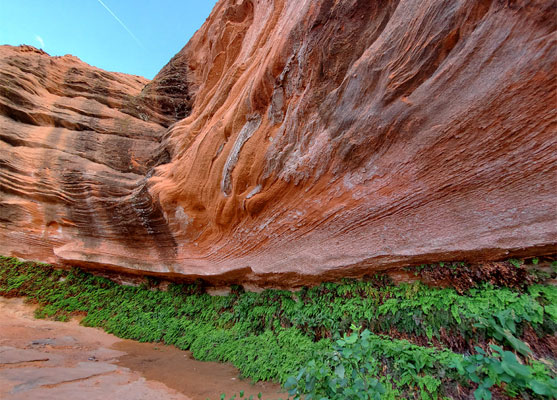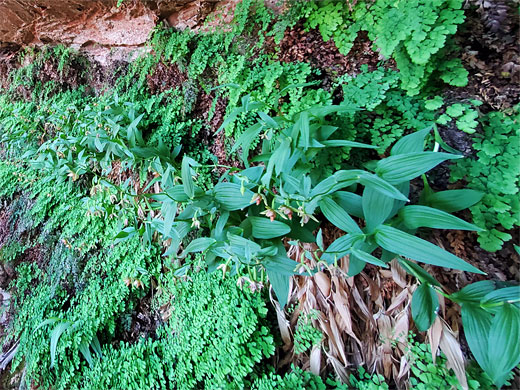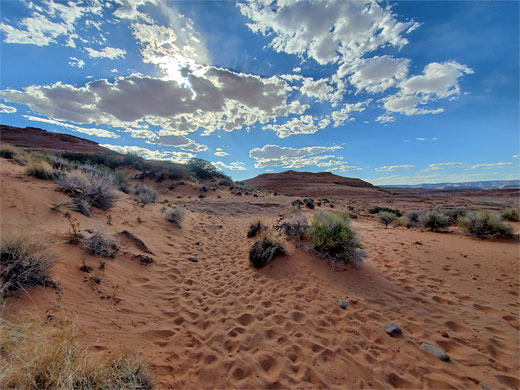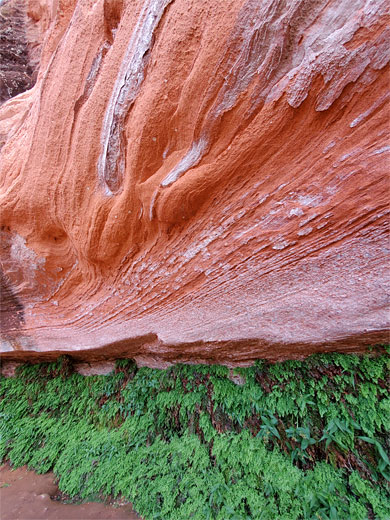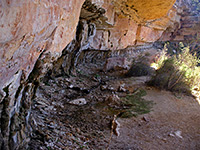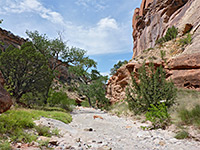Hanging Garden Trail
Short route that crosses a sandstone plateau with views of Lake Powell, to a shady, north-facing alcove harboring riparian plants including maidenhair ferns and stream orchids
Length: 0.6 miles
Elevation change: 30 feet
Difficulty: Easy
Type: One-way
Usage: High
Season: All year
Trailhead: Parking place along Chains Road, off US 89
Rating (1-5): ★★★★★
Elevation change: 30 feet
Difficulty: Easy
Type: One-way
Usage: High
Season: All year
Trailhead: Parking place along Chains Road, off US 89
Rating (1-5): ★★★★★
Hanging gardens are colonies of plants that grow on vertical or inclined surfaces, usually cliffs or alcoves, often at a point where water seeps out from the rock, at a boundary between porous and impermeable layers. They are generally found in canyons or other cool, shady places, yet one good example occurs in the open sand and slickrock terrain north of Page in northern Arizona, just within Glen Canyon NRA.
Most of the surrounding area, including the land bordering the Lake Powell, is a flat expanse of Navajo Sandstone but towards the town is a slightly higher plateau; a low mesa (Potato Hill) of Page Sandstone topped by a thin layer of the Carmel Formation, and an alcove on the north-facing side shelters one such plant colony, sustained in this otherwise arid setting by a year-round water supply, from a seep. The two most abundant plant species found here are maidenhair fern and stream orchid (epipactis gigantea), this latter in bloom between April and July.
The alcove is easily reached, by a 0.6 mile hike, almost level. All hanging gardens are delicate and must be viewed with care; people are requested not touch any of the plants or otherwise disturb the natural environment.
The trailhead for the Hanging Gardens Trail is just off US 89 on the north edge of Page, a quarter of a mile along the gravel track to The Chains, a hiking/swimming area bordering Lake Powell, with views of Glen Canyon Dam. The path heads due north over slickrock and sand, aiming for a gap between the edge of Potato Hill and a smaller Page sandstone mesa to the west. It bends right, now heading directly towards the cliffs on the north side of the hill, rising just a little more steeply towards the end, and then reaches the alcove, which is part of a elongated moist and sheltered area, as shown by a long line of bushes and shrubs at the base of the cliff, including willow and barberry. The alcove itself is about 100 feet across, and the plants here seem to be sustained only by seepage; there is no flowing or dripping water. The band of ferns and orchids is two to three feet high, right at the base of the cliff, and the overhanging rocks ensure that the area stays cool and moist all year, never directly illuminated by the sun.
Most of the surrounding area, including the land bordering the Lake Powell, is a flat expanse of Navajo Sandstone but towards the town is a slightly higher plateau; a low mesa (Potato Hill) of Page Sandstone topped by a thin layer of the Carmel Formation, and an alcove on the north-facing side shelters one such plant colony, sustained in this otherwise arid setting by a year-round water supply, from a seep. The two most abundant plant species found here are maidenhair fern and stream orchid (epipactis gigantea), this latter in bloom between April and July.
The alcove is easily reached, by a 0.6 mile hike, almost level. All hanging gardens are delicate and must be viewed with care; people are requested not touch any of the plants or otherwise disturb the natural environment.
The Trail
The trailhead for the Hanging Gardens Trail is just off US 89 on the north edge of Page, a quarter of a mile along the gravel track to The Chains, a hiking/swimming area bordering Lake Powell, with views of Glen Canyon Dam. The path heads due north over slickrock and sand, aiming for a gap between the edge of Potato Hill and a smaller Page sandstone mesa to the west. It bends right, now heading directly towards the cliffs on the north side of the hill, rising just a little more steeply towards the end, and then reaches the alcove, which is part of a elongated moist and sheltered area, as shown by a long line of bushes and shrubs at the base of the cliff, including willow and barberry. The alcove itself is about 100 feet across, and the plants here seem to be sustained only by seepage; there is no flowing or dripping water. The band of ferns and orchids is two to three feet high, right at the base of the cliff, and the overhanging rocks ensure that the area stays cool and moist all year, never directly illuminated by the sun.
Hanging Garden Trail - Similar Hikes
All Contents © Copyright The American Southwest | Comments and Questions | Contribute | Affiliate Marketing Disclosure | Site Map
